Gigabyte Z77X-UP4 TH Review: Thunderbolt Times Two
by Ian Cutress on September 17, 2012 11:00 AM EST- Posted in
- Motherboards
- Gigabyte
- Z77
- thunder
USB Speed
For this benchmark, we run CrystalDiskMark to determine the ideal sequential read and write speeds for the USB port using our 240 GB OCZ Vertex3 SSD with a SATA 6 Gbps to USB 3.0 converter. Then we transfer a set size of files from the SSD to the USB drive using DiskBench, which monitors the time taken to transfer. The files transferred are a 1.52 GB set of 2867 files across 320 folders – 95% of these files are small typical website files, and the rest (90% of the size) are the videos used in the Sorenson Squeeze test.
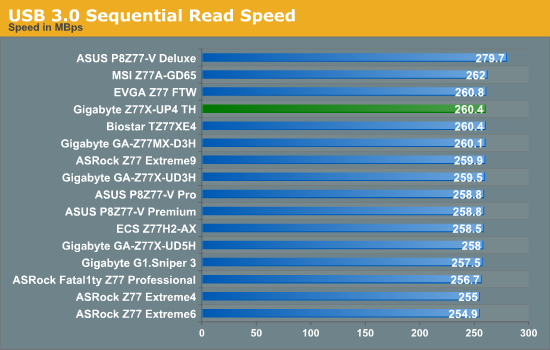
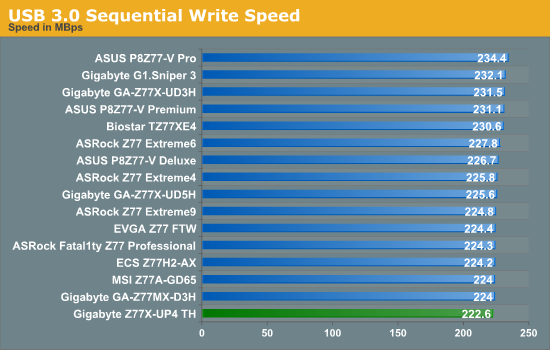
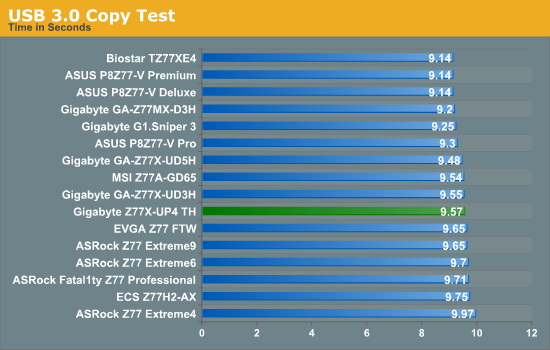
Nothing obscenely wrong comes from the Gigabyte in terms of USB 3.0 speed – even through the write speed was lower than the rest, it came mid-pack in terms of our copy test (the CPU speed may have helped here). Though out USB 3.0 copy test is starting to separate out in terms of vendor – first comes ASUS, then Gigabyte and finally ASRock.
SATA Testing
We also use CrystalDiskMark for SATA port testing on a C300 drive. The sequential test (incompressible data) is run at the 5 x 1000 MB level. This test probes the efficiency of the data delivery system between the chipset and the drive, or in the case of additional SATA ports provided by a third party controller, the efficiency between the controller, the chipset and the drive.
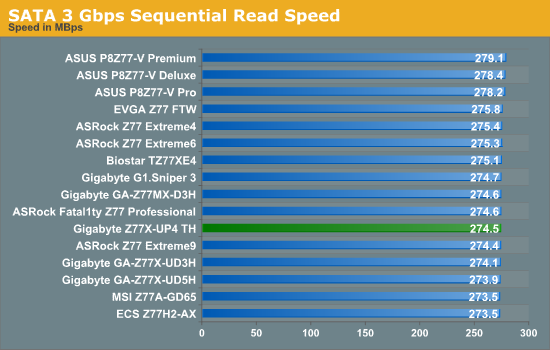
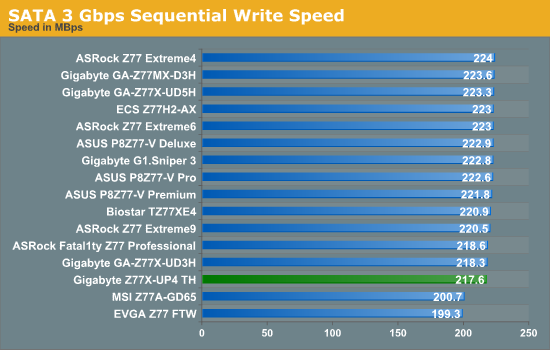
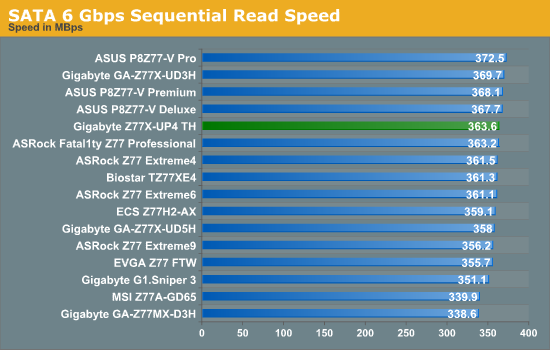

The odd blips we see from some other motherboards in terms of SATA speed are not seen here on the Z77X-UP4 TH, although the writing speed seems a little slow.
DPC Latency
Deferred Procedure Call latency is a way in which Windows handles interrupt servicing. In order to wait for a processor to acknowledge the request, the system will queue all interrupt requests by priority. Critical interrupts will be handled as soon as possible, whereas lesser priority requests, such as audio, will be further down the line. So if the audio device requires data, it will have to wait until the request is processed before the buffer is filled. If the device drivers of higher priority components in a system are poorly implemented, this can cause delays in request scheduling and process time, resulting in an empty audio buffer – this leads to characteristic audible pauses, pops and clicks. Having a bigger buffer and correctly implemented system drivers obviously helps in this regard. The DPC latency checker measures how much time is processing DPCs from driver invocation – the lower the value will result in better audio transfer at smaller buffer sizes. Results are measured in microseconds and taken as the peak latency while cycling through a series of short HD videos - under 500 microseconds usually gets the green light, but the lower the better.
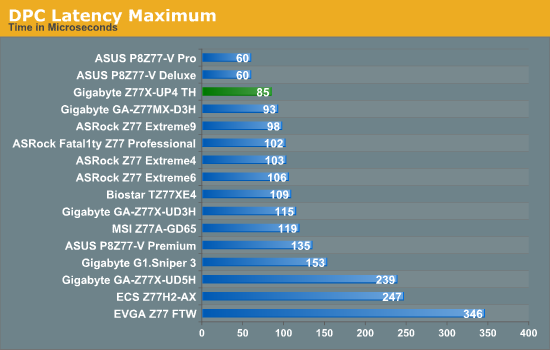
Despite the Z77X-UP4 TH falling victim to the H/W Monitor bug in terms of DPC testing (raising the value to 800+), when turned off the peak DPC Latency was 85 microseconds which is an excellent result.










15 Comments
View All Comments
ElFenix - Monday, September 17, 2012 - link
"Despite all this, Gigabyte’s foray into the Thunderbolt world is spurned in part by the board we are reviewing today...."You probably meant 'spurred,' though that doesn't really fit either.
Also, the very first sentence should be more like "Because the exclusive license has expired...."
IanCutress - Monday, September 17, 2012 - link
Thanks for pointing the first one out - it should have been 'initiated in part'. As to the phrasing of the first sentence, I find it common enough where I am. Not sure if it's a UK thing or not, though US vs. UK idioms have been commented on in past reviews. As always, if anything catches your eye please feel free to email :)Ian
freedom4556 - Monday, September 17, 2012 - link
Speaking of UK vs US, I had to Google your Stella Artois reference, and I actually drink the stuff occasionally. Must have been a UK specific ad campaign.lurker22 - Monday, September 17, 2012 - link
I understand that Thunderbolt is a lot faster and a different usage than USB 3. Frankly, it's not so much better than USB 3 that consumers will pay for Thunderbolt. USB 3 is already leading, and Thunderbolt will be left behind like Firewire despite the tech being superior...dagamer34 - Monday, September 17, 2012 - link
It's rather meh on desktops since it's pretty easy to add new hardware internally, but it makes far more sense on laptops when you have limited number of ports. Having an external PCI-Express bus is interested, especially if external GPUs ever actually arrive at an affordable price point.Kjella - Monday, September 17, 2012 - link
If you're going to plug in one device, yes. I think the strength of Thunderbolt is as a laptop dock - plug in one cable and you got wired network, sound, keyboard, mouse, printers external screens, any USB 1/2/3.0 device, firewire, esata, external graphics card dock, regular 3.5" HDDs and whatnot. That can have a future in many companies I think who've now chosen laptops for higher flexibility - now you can have that and dock into a full system with one cable.sean.crees - Monday, September 17, 2012 - link
It will mean a lot if they ever put thunderbolt on a mini itx board. I know a lot of SFF enthusiasts who would love to try external graphics with a sub 10 liter enclosure. But on a full size ATX board it doesn't really mean a whole lot.Skidmarks - Tuesday, September 18, 2012 - link
That's possibly true but only time will tell.GeorgeH - Monday, September 17, 2012 - link
It really would've been nice to see some Thunderbolt testing. I realize Anand is hogging all of the shiny TB gear, but the review didn't really test the primary draw of this MB and as such is kind of useless.zanon - Monday, September 17, 2012 - link
Agreed. As the summary correctly states, the raison d'etre of this board are the TB ports. Even if it's just the overpriced Promise a review should give them some stress and see how they perform. Maybe it'll get easier if QNAP ever releases their JBOD.